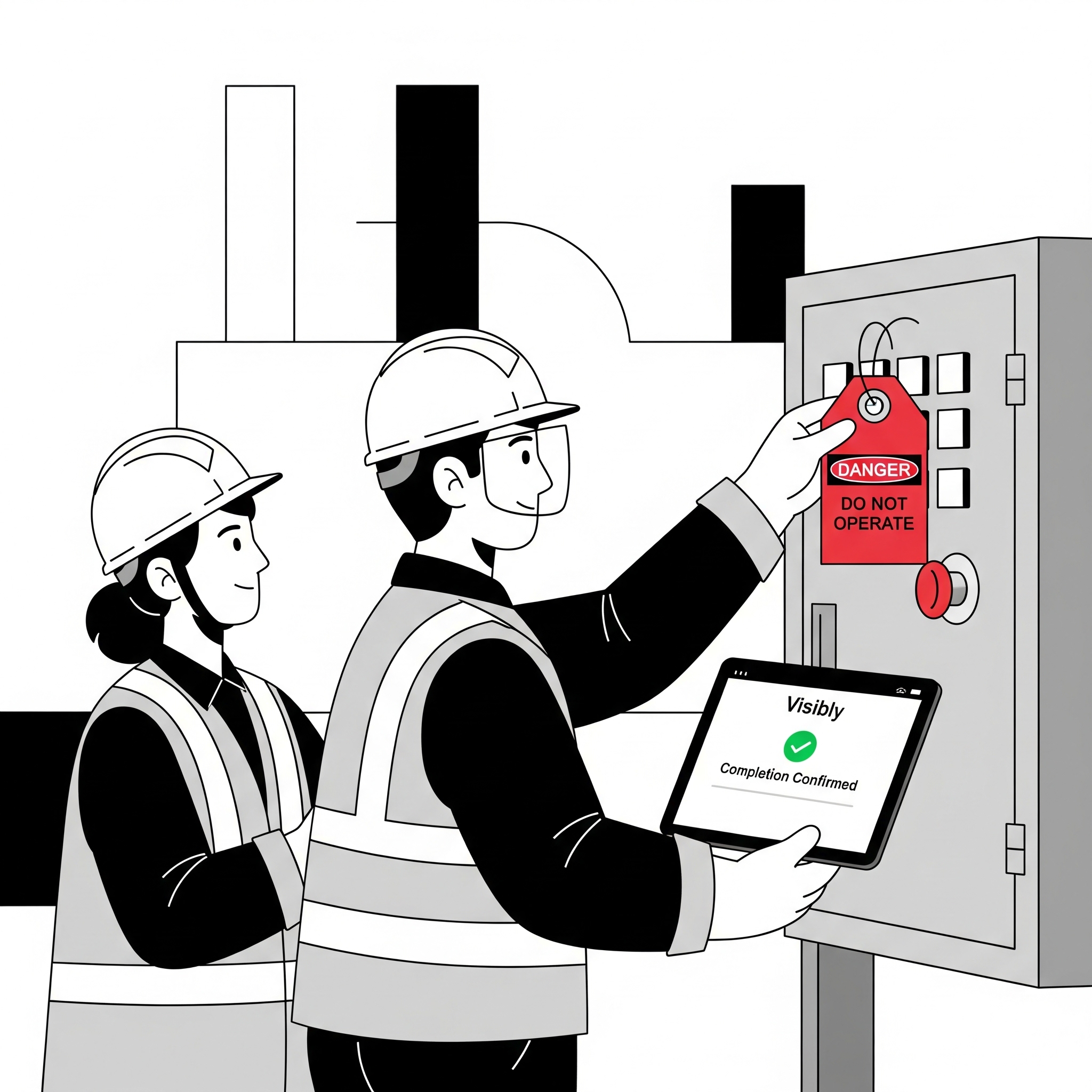
Lockout/Tagout (LOTO) Procedures: Your Most Common Questions Answered
This guide answers the most common LOTO questions we hear from safety and operations teams, and highlights where procedures often fall short.

Picture this.
It’s 5:15 AM at a major UK food manufacturing plant. The early shift is underway, prepping the packing line for a high-volume production run. A technician steps in to clear a blockage in the conveyor belt. The line supervisor thinks the system’s been isolated, the tag is on the control panel.
But the isolation point? It’s 12 metres away, on the far side of the plant. A second operator, unaware of the jam, resets the control system.
The conveyor jolts to life.
The technician’s arm is caught before anyone can reach the emergency stop.
Scenarios like this aren’t rare. They happen when critical information is siloed. When paperwork is out of date. When isolation procedures are improvised instead of embedded. And when time pressure leads to assumptions.
In industries where high-speed machinery, moving parts and pressurised systems are part of daily operations, Lockout/Tagout (LOTO) isn’t a box to tick. It’s a basic line of defence.
This guide answers the most common LOTO questions we hear from safety and operations teams, and highlights where procedures often fall short.
1. What is Lockout/Tagout (LOTO)?
Lockout/Tagout is a method of physically isolating machinery or systems to protect workers during maintenance or servicing.
- Lockout involves applying a secure lock to an energy-isolating device (like a valve or switch) to prevent operation.
- Tagout means attaching a visual warning label that clearly shows the equipment must not be used (when a repair or maintenance is taking place).
The goal is simple: stop machines starting up or energy being released while someone is in harm’s way.
2. What types of stored energy should we watch out for?
Stored energy goes far beyond electricity. In food production, infrastructure or utilities, the following are common:
- Hydraulic energy – in pistons, lifters, compactors (e.g. packaging lines or crate stackers)
- Pneumatic energy – in compressed air systems powering automated arms or valve actuators
- Mechanical energy – from rotating shafts or spring-loaded mechanisms
- Gravity – in suspended hoppers or vertically stacked trays
- Thermal energy – in heating systems, steam lines, or sterilisation equipment
- Chemical energy – in cleaning agents stored under pressure
Any one of these can cause serious injury if not fully isolated and discharged.

3. Who’s responsible for carrying out LOTO?
Responsibility typically lies with the person performing the maintenance or repair task. They should apply their own lock and tag. But wider responsibility also sits with:
- Supervisors – to check LOTO is being followed
- HSEQ teams – to ensure procedures are clear, current and embedded
- Maintenance planners – to allow time for safe isolation
A single person taking control of the whole LOTO process isn’t enough. It requires shared accountability across teams, especially where shift handovers or subcontractors are involved.
4. What should a proper LOTO procedure include?

A robust LOTO procedure involves:
- Identifying all energy sources – including secondary systems
- Notifying affected personnel – so no one restarts the system
- Shutting down the equipment – using standard stop procedures
- Isolating all energy sources – using switches, valves, or breakers
- Applying locks and tags – clearly labelled and traceable
- Verifying isolation – attempting to start or test the system safely
- Carrying out the work
- Removing locks and tags only once everyone is clear and it’s safe
LOTO should never be rushed or left to memory. It needs to be written, taught and tested.
See: The Safe Isolation of Plant and Equipment (HSG 253) - Health and Safety Executive
5. What’s the legal requirement in the UK?
Whilst LOTO doesn't have an explicit regulation, LOTO practices support compliance with multiple UK regulations, including:
- The Provision and Use of Work Equipment Regulations 1998 (PUWER)
- The Electricity at Work Regulations
- The Health and Safety at Work Act
Each of these frameworks requires:
- Safe isolation of hazardous energy
- Risk assessments for maintenance tasks
- Suitable systems of work and training
6. Why do LOTO procedures often break down?
From what we’ve seen, LOTO failures usually happen because:
- Isolation points aren’t clearly identified
- There’s no visual or physical confirmation of lockout
- Work is rushed due to production pressure
- Subcontractors or temporary staff aren’t briefed properly
- Paper checklists are utdated and don't reflect current equipment or isolation points
- Tags are used without locks, or placed on the wrong equipment or location
In food factories and rail maintenance depots alike, communication gaps are often the weakest link.
7. Can LOTO be integrated with other safety processes?
Absolutely. LOTO should connect directly with:
- Permit to Work systems
- RAMS documents
- Toolbox talks
- Planned maintenance systems
If isolation is treated as a standalone step, it’s more likely to be missed. But when it’s embedded across workflows, the risk of error drops significantly.
Final Thoughts
Whether you’re running a production line, maintaining overhead power lines, or clearing a blocked valve on a remote site, LOTO is one of the simplest, and most essential safety tools available.
Done well, it protects people, keeps operations running smoothly, and helps organisations stay on the right side of the law.
Done poorly, it’s a gamble. And when the stakes are this high, that’s not something anyone can afford.
Want to reduce the admin burden around compliance while keeping your teams protected?
Visibly helps operational and safety leaders stay audit-ready and aligned across multiple sites and subcontractors.








.png)



